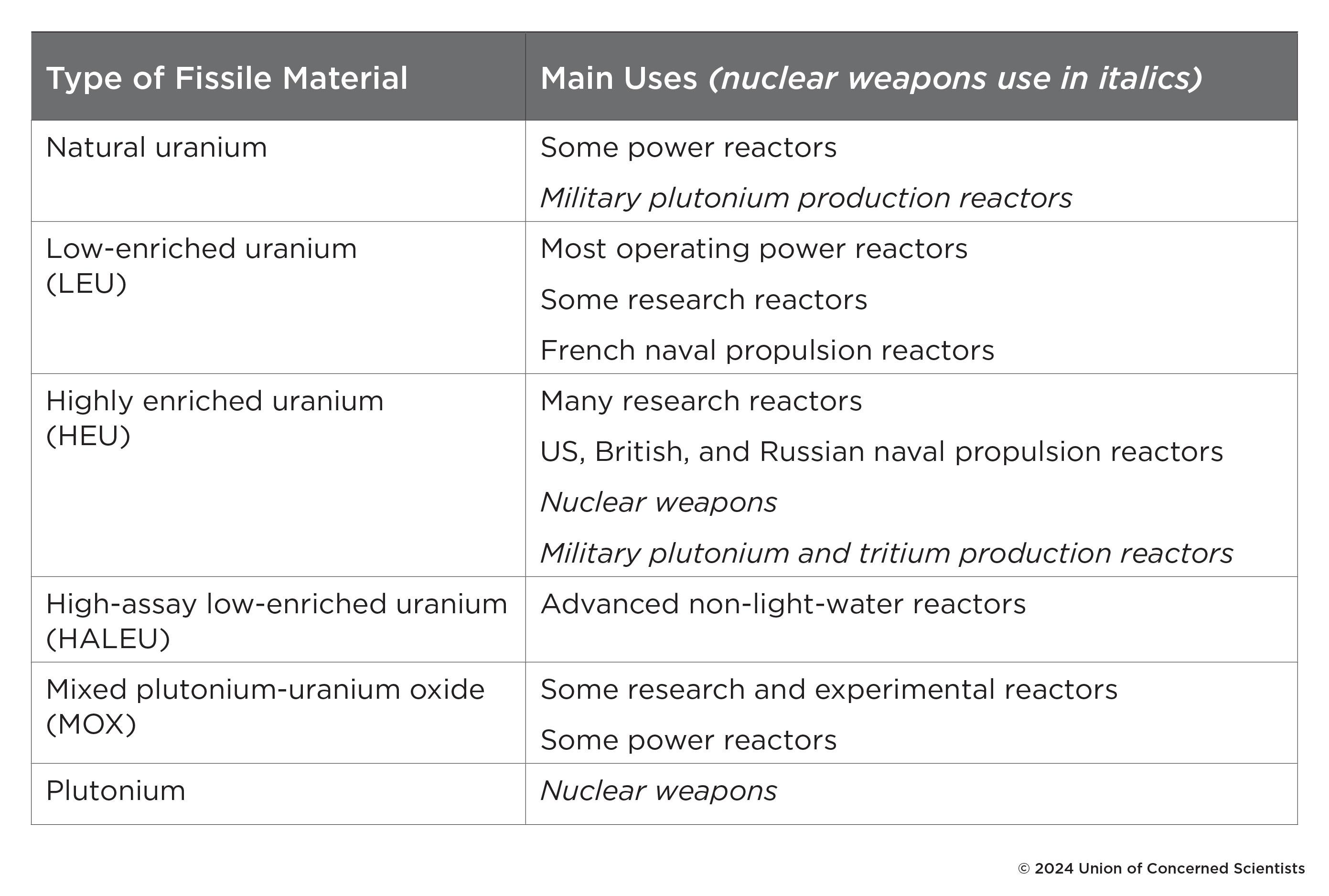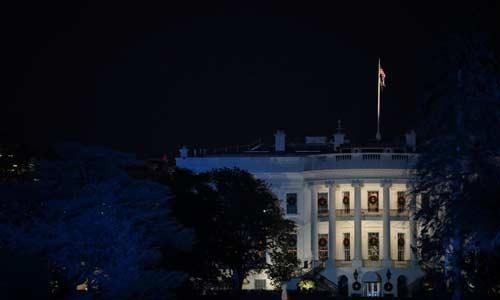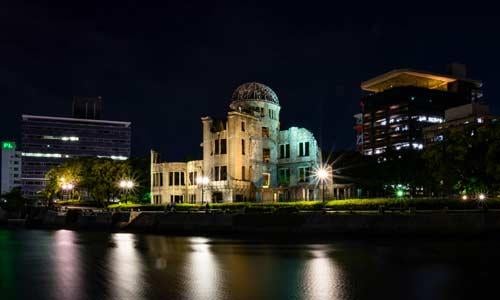Nuclear reactors and nuclear weapons derive power through the fission (splitting) of uranium or plutonium nuclei by neutrons, a process that releases large amounts of energy. Obtaining fissionable materials, either by producing them or by stealing them, is a necessary but technically challenging step for states or sub-national terrorist groups seeking to build a nuclear weapon.
The risk of nuclear terrorism and the potential for non-weapon states to build nuclear bombs raise concerns about the security of existing fissile materials, the accessibility of technology for their production, and the detectability of materials being diverted to covert nuclear programs. Securing and tracking these materials, and establishing standards and procedures to control the management and use of fissile material stocks, is critical in preventing their diversion for weapons purposes and is a core mission of various international and national organizations.
Notably, the International Atomic Energy Agency (IAEA) is charged with ensuring, through a system of international safeguards, that nations do not divert fissionable materials from peaceful uses to weapons programs. In contrast, protection of such materials from theft by terrorists is regarded as a sovereign responsibility of states, and the IAEA has no legal authority over national physical protection programs, although it provides assistance when requested.
To be used for weapons, uranium must be mined, processed, and enriched. Plutonium is produced by irradiating uranium in a nuclear reactor and reprocessing the spent fuel rods. The production, use, and disposal of fissile materials and their byproducts, which often remain radioactive for extended periods, can contaminate the environment and pose significant health risks if not handled and disposed of properly. This webpage provides an overview of fissile materials, the risks they pose in terms of nuclear proliferation, and their potential health impacts.
What Are Fissile Materials?
Fissile material consists of nuclei that can be induced to split apart when bombarded by low-energy thermal (slow) neutrons. Some fissile materials can sustain chain reactions. When an atom of such material is split into two smaller nuclides, it also releases energy and one or more fast neutrons. These neutrons can cause subsequent fissions, and under the right conditions a self-sustaining chain reaction can occur. The two most important fissile materials for civil and military purposes are uranium-235 and plutonium-239. The numbers 235 and 239 denote the isotope of the element. Isotopes are atoms of the same element that differ only in their numbers of neutrons. Isotopes of an element thus have slightly different masses.

Uranium. Uranium is a naturally occurring element, but it is not found in a form that is directly usable for nuclear weapons. Natural uranium consists mostly of two different isotopes, approximately 0.7 percent uranium-235 (the isotope essential for nuclear weapons) and 99.3 percent uranium-238. To convert natural uranium into a form that can be used in nuclear weapons, it must be "enriched" to increase the concentration of uranium-235.
Enriching uranium is both technically difficult and expensive, as it requires separating isotopes that have very similar chemical and physical properties. The enrichment process is thus the main barrier to producing uranium suitable for use in nuclear weapons.
The level of uranium-235 concentration is a major factor in determining the utility of uranium as a fuel for nuclear reactors or nuclear weapons. Low-enriched uranium (LEU) contains between 0.7 percent and 20 percent uranium-235. A typical light-water nuclear reactor uses uranium enriched from 3.5 to 5 percent uranium-235. Highly enriched uranium (HEU) contains 20 percent or more uranium-235. Weapons-grade HEU is typically enriched to 90 percent uranium-235 or more, but all HEU can potentially be used to make nuclear weapons with sufficient quantity and expertise. In addition, despite a widespread belief that high-assay low-enriched uranium (HALEU) cannot be used directly in a nuclear weapon, independent analysis strongly suggests that it is weapon-usable, although the required quantities are larger than for weapons-grade HEU. Many so-called "advanced" reactors, such as the Natrium fast reactor that the company TerraPower is applying to build in Kemmerer, Wyoming (and eventually export around the world) would require quantities of HALEU sufficient for nuclear weapons.
The difficulty and expense of the enrichment process have an important consequence: HEU can be diluted with natural uranium to produce LEU for light-water reactors, effectively eliminating the risk that it could be used to make a nuclear weapon if stolen by terrorists. However, as sophisticated enrichment technology spreads around the world, more groups can overcome the technical barriers to producing HEU for weapons. The illicit transfer of enrichment technology from Pakistan to countries like the Democratic People's Republic of Korea (North Korea) and Iran has underscored the urgency of stringent measures to prevent the misuse and diversion of HEU and enrichment technology. Moreover, the commercial enrichment facilities used to make LEU fuel for commercial nuclear reactors can be reconfigured to produce HEU for weapons. Without strong regulations in place, these dual-use facilities pose risks of nuclear weapons proliferation.
Plutonium. Plutonium occurs only in trace amounts in nature. It is produced in nuclear reactors or particle accelerators when uranium is irradiated with neutrons. Countries producing plutonium for weapons can operate reactors in a way that maximizes the production of plutonium-239—the isotope most useful for nuclear weapons—and minimizes the production of other plutonium isotopes such as plutonium-240. Certain nuclear reactors are more optimized for producing plutonium-239, including graphite or heavy-water moderated reactors (such as the B Reactor previously used in Hanford, Washington, or the 5 MWe reactor in Yongbyon, North Korea), and fast breeder reactors. The latter are specifically designed to breed more fissile materials than they use as part of their operation.
To use plutonium in nuclear weapons or nuclear fuel, it must first be separated from the rest of the spent fuel components in a reprocessing facility. Plutonium separation is easier than uranium enrichment because it involves separating different elements rather than different isotopes of the same element. It uses well-established chemical separation techniques such as solvent extraction, or the plutonium uranium extraction (PUREX) process. However, since the spent fuel is highly radioactive, this process requires heavily shielded facilities with remote-handling equipment.
Weapons-grade plutonium contains more than 93 percent plutonium-239 and less than 7 percent plutonium-240 by weight. Comparatively, reactor-grade plutonium contains roughly 76 percent plutonium-239 and 24 percent plutonium-240. One often hears the claim that the relatively high amounts of plutonium-240 can lead to premature detonation of a weapon, making it less favorable for nuclear weapons design. However, this is misleading. Even a weapon that fizzles could cause an explosion roughly equivalent to 1,000 tons (1 kiloton) of TNT: sufficient to kill tens of thousands of people if detonated in a city. Moreover, states with advanced nuclear weapon capabilities could overcome the pre-detonation problem and use reactor-grade plutonium in weapons with no degradation in assured yield. Thus, all isotopic compositions of plutonium need to be rigorously safeguarded and protected against theft.
Another terrorist risk arises from the manufacture, transportation, and storage of mixed plutonium-uranium oxide (MOX) fuel, used in some research and power reactors. While MOX fuel itself is unlikely to be used to make nuclear weapons, the plutonium can be separated from the uranium by a straightforward chemical process. Moreover, MOX does not contain the highly radioactive components that make spent fuel difficult and dangerous to reprocess. As a result, MOX is as great a terrorist and proliferation concern as plutonium itself.
Fissile Materials and Human Health
Plutonium and uranium have both chemical and radiological effects on the human body.
Most plutonium isotopes are intense emitters of alpha particles, which pose relatively low radiological hazards outside the body but are much more harmful if inhaled or ingested. People can be exposed to plutonium by working at or living near nuclear facilities where plutonium is processed, such as a reprocessing plant. This could happen through inhalation from a nearby release caused by a lab leak or fire, ingestion of contaminated water or food, or in a work setting where someone is exposed to radioisotopes due to a torn or faulty laboratory glove box, causing the hands and arms to be exposed. Plutonium has been associated with many diseases, especially cancers of the bone, liver, and lung. Epidemiological studies in young animals have shown that plutonium deposited in the lung may migrate to developing bones. It is important to also note that the amount of plutonium absorbed by bones and the corresponding health effects can vary between children and adults.
Unlike plutonium, natural uranium exists in almost all soil, water, and rock across the planet, but the radioactivity from this naturally occurring ore is low compared to that of plutonium.
Uranium exposure is most commonly the result of inhalation by workers who mine or process uranium. For example, uranium mill tailings that are not properly maintained can result in the environmental release of radioisotopes and other chemicals. The general public is more likely to be exposed to uranium by drinking or eating contaminated substances.
When uranium enters the body, harmful chemical reactions can result in autoimmune function disorder, high blood pressure, kidney disease, and compromised reproductive health. Because of the long half-life of its major isotopes, uranium has a much lower radiotoxicity than plutonium, but exposure to uranium decay products such as radon gas can cause various cancers. Children are disproportionately harmed by uranium due to their increased radiosensitivity and having more growing bones that will store uranium.
How Much Is Needed to Build a Bomb?
The amount of fissile materials needed to make a nuclear weapon varies with the degree of enrichment, the sophistication of the weapon design, and the intended yield. In general, higher enrichment levels and lower intended yields mean less fissile material needed to make a bomb.
The first working nuclear weapons were based on two basic design options: a "gun-type" weapon, in which two pieces of HEU are brought together quickly and explode, and an "implosion-type" weapon, in which a sphere of weapon-usable material is rapidly compressed symmetrically. The bomb dropped on Hiroshima, "Little Boy," was a gun-type uranium weapon. The bomb dropped on Nagasaki, "Fat Man," was an implosion-type plutonium weapon. Notably, plutonium-based nuclear weapons use this implosion method exclusively because gun-type weapons are more susceptible to pre-detonation.

Which Countries Have Fissile Materials for Weapons Use?
As of 2024, the global stockpile of highly enriched uranium is 1,250 metric tons and separated plutonium is 550 metric tons. Today, countries with fissile materials for weapons purposes include the five nuclear weapons states designated by the Non-Proliferation Treaty (China, France, Russia, the United Kingdom, and the United States), as well as non-nuclear-weapons states including India, Iran, Israel, North Korea, and Pakistan.
Challenges in Accounting for Fissile Material Stockpiles and Preventing Nuclear Proliferation
The lack of availability of weapon-usable fissile materials is the main constraining factor for building nuclear weapons, and the quantities of fissile materials a state has made and could make are important indicators of the size of a country's nuclear arsenal and its potential to expand it. However, accurately determining the stockpiles is challenging, as even under IAEA agreements, the ability to independently verify a country's declared fissile material inventory is limited.
Responsible states enact safeguards against the theft of nuclear materials and nuclear weapons, but the possibility of terrorists obtaining fissile materials in sufficient quantities to produce a rudimentary nuclear weapon must be taken seriously.
In addition, the use of other types of radioactive material (fission products) in a conventional weapon, or "dirty bomb," can have severe consequences, including psychological impact, increased cancer risks proportional to radiation exposure, economic disruption, and expensive cleanup efforts. Unlike a nuclear bomb that relies on nuclear fission or fusion reactions, a dirty bomb functions like dynamite with radioactive materials. While it does not create a nuclear blast, it disperses radioactive contamination through a conventional explosion, which can spread for a few blocks or even miles.
The Non-Proliferation Treaty (NPT) serves as a cornerstone international agreement aimed at preventing the spread of nuclear weapons and promoting disarmament. It provides a framework for peaceful uses of nuclear energy under the supervision of the IAEA. The IAEA plays a pivotal role in overseeing nuclear activities worldwide, including the verification of non-diversion of fissile material through standard safeguards agreements and verification of the absence of undeclared nuclear activities through the Additional Protocol signed by most NPT signatories. The Nuclear Security Summits initiated by President Obama brought together world leaders to secure vulnerable nuclear materials and prevent nuclear terrorism, complementing IAEA's non-binding efforts. Under the summits, more than 260 national commitments were made, 150 nuclear weapons' worth of HEU and plutonium were removed, and 37 countries committed to counter nuclear smuggling efforts.
Limiting Fissile Material Stockpiles
A Fissile Material Cut-off Treaty has been proposed that would ban the production of fissile materials for nuclear weapons purposes. Even though the treaty has been on the agenda of the UN Conference on Disarmament for many years, little progress has been made towards its negotiation and ratification. Challenges and disagreements include issues of verification and compliance, with some countries expressing concern over the verification mechanisms given the sensitivity to national security, as well as scope and definitions, including which materials and facilities should be covered by the treaty.
Despite these challenges, efforts to negotiate the cut-off treaty should continue as part of the comprehensive multilateral arms control framework that includes the Non-Proliferation Treaty and the Comprehensive Test Ban Treaty, which would ban explosive nuclear testing.




